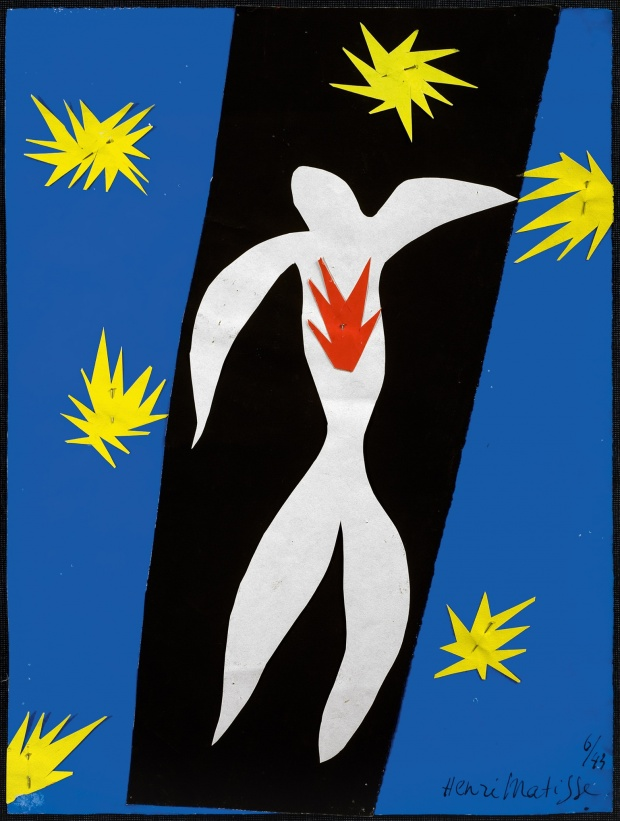Creative Sketchbook, Module 1,
Chapter 5An Additional Activity – A Visit to the Matisse Cut-Outs
This is a prequel to ‘Finding Out About Henri Matisse’ in
Chapter 8, because I’ve been to see the Cut-Outs Exhibition at Tate Modern, and
Chapter Five is all about Cut-Outs
I came away converted. Not only do I begin to understand a little about some of Matisse’s work, but I like it, and I can see how it relates to what we are doing. His use of colour and shape, negative and positive space and so on was very inspiring, and it was interesting to see how he worked – there were a couple of short films, showing how he wielded the most enormous pair of shears, ‘cutting into colour’ as he himself described it.
In the films he cut freehand, producing wonderfully fluid shapes, but I gather that sometimes he did draw an outline on the paper. And, in case you’re wondering (well, I certainly did), he had an array of scissors in various sizes. So presumably he used smaller ones for the more detailed and intricate work.
I hadn’t realised
that for the last 17 years of his life (he died in 1954) Matisse was confined
to a wheelchair and was unable to paint, so he turned to paper cutting to
express his ideas. It was a technique he had used on occasions in the past to
create drafts of his paintings, but he took it to a whole new level. He cut
shapes from paper painted by his assistants, who used gouache, producing a
flat, even colour, with no shading. The colours were selected by Matisse – he
had sample squares prepared to show exactly what he wanted. The assistants lightly
pinned the cut-out pieces of paper to the walls of Matisse’s studio, leaving
them free to move in the wind. Bits were added, taken away, altered and moved
until Matisse was satisfied with the composition, and it was finally stuck on paper,
canvas or board.
When you look at
the pictures they are so seamless it’s hard to remember they are created from
pieces of paper – in fact, I’d always assumed things like Blue Nude and The
Snail, which are among his most iconic images, were painted.
 |
| The Snail |
Then there are
the human figures, reduced to their simplest form, but it’s a deceptive
simplicity, because these are the stars of circus and stage, acrobats and
dancers, swooping and leaping with joy. How can anyone convey movement and
energy in just a few flowing blocks of colour?
And such colours!
They are amazing: bold, bright, loud, and pure, they sing and shout from their
paper settings, demanding attention. My personal preference has always been for
a more muted palette, with shades of pale, harmonious colours (you won’t find
anything bright or clashing in my house or wardrobe). I should be well out of
my comfort zone at this exhibition (even more so when you consider that on the
whole I tend to like paintings that look like what they are meant to be). But I
love it! It’s one of those ‘wow’ moments when something I’ve never understood
suddenly starts to make sense, and I can enjoy it.
He believed exactitude in art was not important. He
stressed that when he painted grass it was not real grass. Like Cezanne, who
tried to create the essence of what he was painting, rather than an exact
replica, Matisse felt it was the emotion of the thing that mattered. “I simply try
to use colours that express my feelings,” he explained.
He
sought the strongest colour effect possible, claiming that colour ‘contributes
to the expression of light’, and that it is a ‘liberation’. I think it was that freedom which enabled him
to embrace cut-outs so whole-heartedly and so successfully when he was old and
ill, and to abandon any remaining shreds of traditional brush and paint
methods. His figures, in particular, are pared down and simplified – not quite
abstract, but definitely a logical progression from his controversial ‘Dancer’
paintings.
 |
| Icarus Falling |
When
talking about his cut-out figures Matisse said: “One mark is enough to evoke a
face. There is no need to impose eyes or a mouth on people – you should leave
the way clear for the spectator’s daydreams.”
And
I think that’s a pretty good ambition, to engage the viewer and draw them into
the picture, and make them think about it, and create their own story about
what it represents, I could have stood and daydreamed for hours in front of any
one of the 120 pictures in this exhibition.
(All Information is from the Tate website).


No comments:
Post a Comment